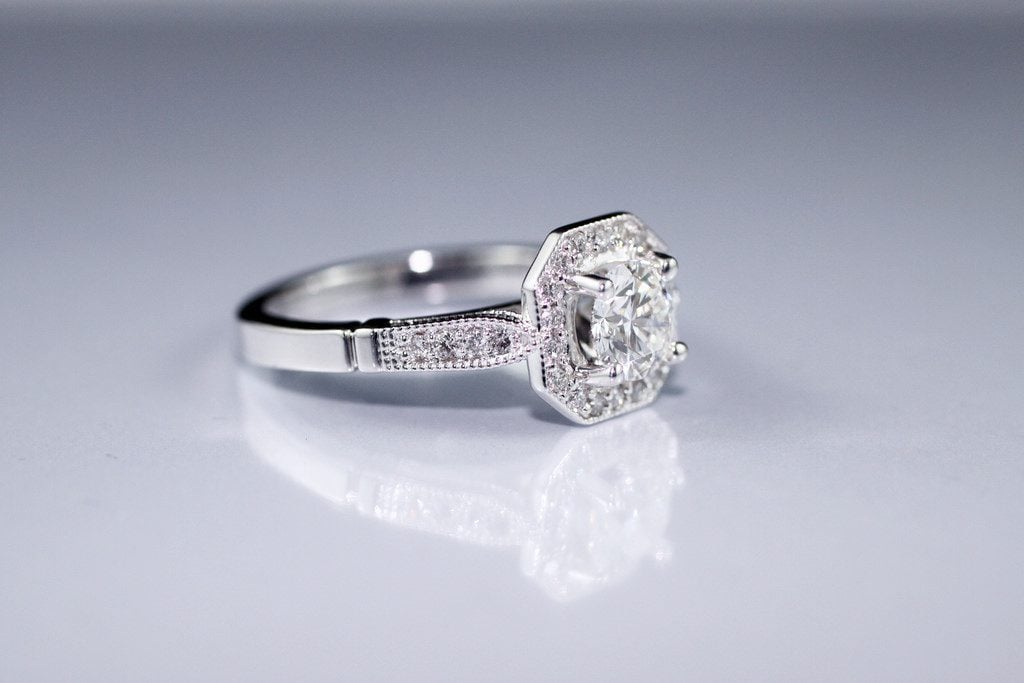Should I Buy a VVS Diamond? 6 Pros & Cons
Before spending money on a VVS diamond, read about the pros and cons of diamonds with this clarity grade. What you learn might surprise you!
3 Minute Read
Nevertheless, when is it a good idea to consider buying a VVS diamond? Read on and learn about the pros and cons of these diamonds.
What is a VVS Diamond?
VVS1 and VVS2 are clarity grades for diamonds. Gemological laboratories like GIA assign clarity grades based on factors such as the number, size, color, and placement of inclusions and imperfections in the diamonds. These things affect the free passage of light through a stone. The more noticeable these inclusions and imperfections, the lower the grade.
Flawless (F) and internally flawless (IF) are the highest clarity grades. After these comes very very slightly included (VVS). VVS1 and VVS2 are different levels of this grade. Next, you have very slightly included (VS1, VS2), slightly included (SI1, SI2), and then included (I1, I2).
Diamonds graded VVS1 and VVS2 have excellent clarity.
Pro: VVS Diamonds are Almost Flawless
The imperfections in VVS diamonds are visible only under high magnification. Even a jeweler's loupe is sometimes insufficient for seeing these imperfections.
Con: Lower Clarity Diamonds can Be "Eye-Flawless"
Although VS diamonds have a lower clarity grade, you still can't see their imperfections with the unaided eye. They're "eye-flawless." The imperfections in SI1 stones are also rarely visible to the untrained eye. Even some SI2 diamonds will appear perfect in an engagement ring! Can you spot the imperfections in this 1.77ct SI2-clarity diamond ring video?
at James Allen
Con: VVS Diamond Price
As the clarity grade improves, price increases. While VVS diamonds aren't as expensive as Flawless, they're more expensive than those with lower clarity. However, a lower clarity grade doesn't impact beauty. If you're buying a VVS diamond, you're likely paying extra for no noticeable difference!
Compare the prices of these three diamonds with different clarity grades. The 1.02-ct VVS1 diamond costs $1,700 more than the 1.01-ct SI2 diamond! Or, if you go with the 1.10-ct VS1 instead of the VVS1, you'll get a larger face-up size for $730 less!
Con: VVS Diamonds as an Investment
While VVS diamonds are rare compared to lower clarity grades, they're still, ultimately, not a good investment. Diamond resale prices are low, and you're unlikely to sell any white diamond for more than its sticker price. Although certain fancy colors may have investment value, this isn't due to clarity.
Pro: More Choices for Rare Sizes, Shapes, or Colors
If you're buying a round brilliant white diamond, there's not much reason to pay extra for a VVS diamond. In fact, we recommend limiting your search to VS2 and SI1 diamonds. However, if you're looking for a particularly large diamond, adding higher clarity grades to your search won't hurt.
Similarly, you'll often have few stones to choose from when looking for a fancy shape or color. Again, including VVS diamonds in your search will only give you more options. Fancy colored VVS diamonds boast exquisite hues, ranging from vibrant blues and pinks to intense yellows and greens. Their exceptional clarity, graded as VVS (Very, Very Slightly Included), ensures these diamonds sparkle with unparalleled brilliance.
Pro: Symbolic or Personal Preference
If there's some other reason you prefer VVS diamonds (perhaps if your name is Victoria Van Slyke), then there's no reason to skip over a VVS diamond, other than its price.
Otherwise, it's best to stick to lower clarity grades and pay for a better cut (or larger carat) diamond.
With the 360° videos offered by James Allen and Blue Nile, you can assess clarity imperfections in great detail. This means you can find a great looking diamond even if it has a lower clarity grade. That's why we recommend using them for diamond shopping - so you can see before you buy!
Addison Rice
A geologist, environmental engineer and Caltech graduate, Addison’s interest in the mesmerizing and beautiful results of earth’s geological processes began in her elementary school’s environmental club. When she isn’t writing about gems and minerals, Addison spends winters studying ancient climates in Iceland and summers hiking the Colorado Rockies.
Related Articles
Diamond Value, Price, and Jewelry Information
Marquise-Cut Diamonds Buying Guide: Vintage & Modern
Old European Cut Diamonds: The Complete Guide
Can Blockchain Diamonds Solve Ethical Sourcing and Grading Issues?
Latest Articles
Opal Buying Guide
Amethyst Sources Around the World: The Geological Story Behind These Purple Gemstones
Brazilianite Value, Price, and Jewelry Information
Ruby-Glass Composites vs Leaded Glass Clarity Enhancements
Never Stop Learning
When you join the IGS community, you get trusted diamond & gemstone information when you need it.
Get Gemology Insights
Get started with the International Gem Society’s free guide to gemstone identification. Join our weekly newsletter & get a free copy of the Gem ID Checklist!
